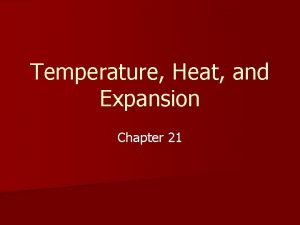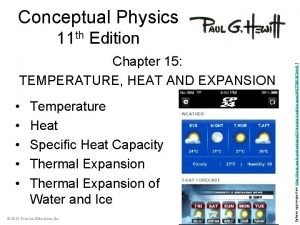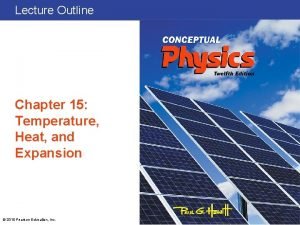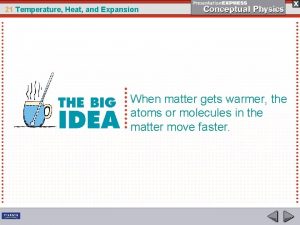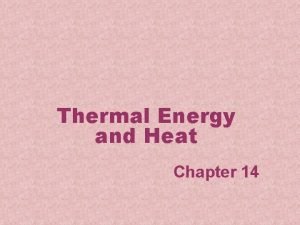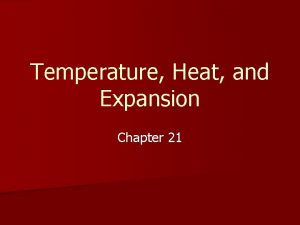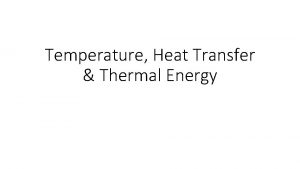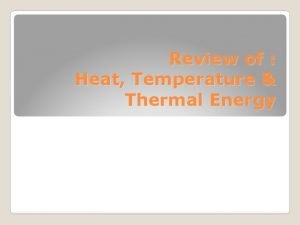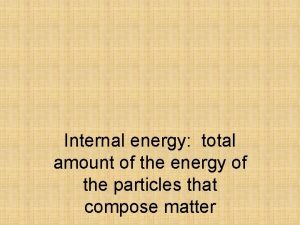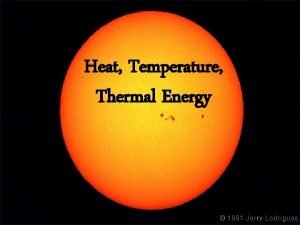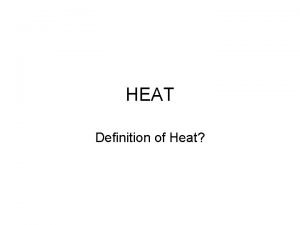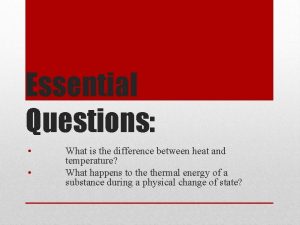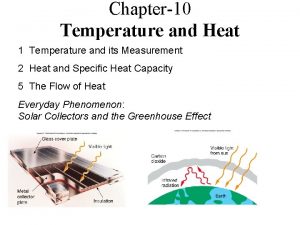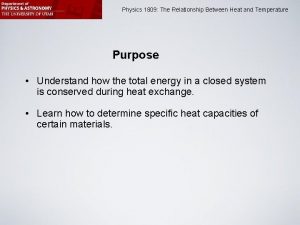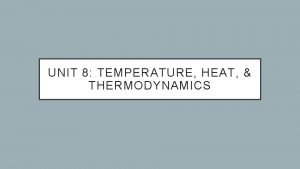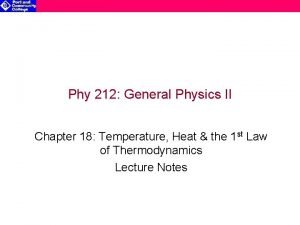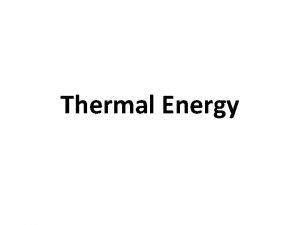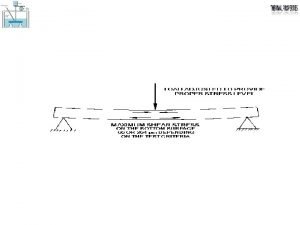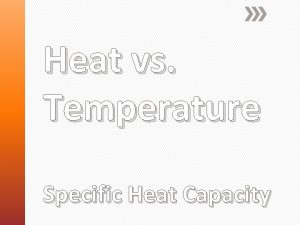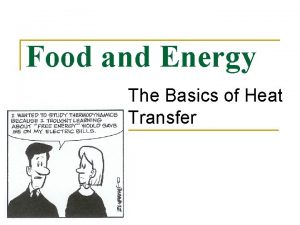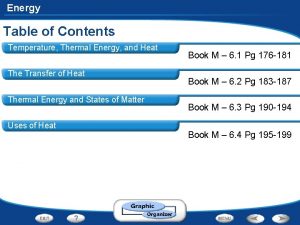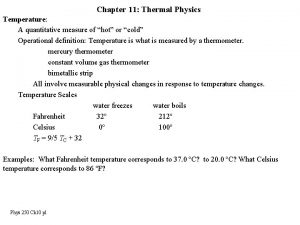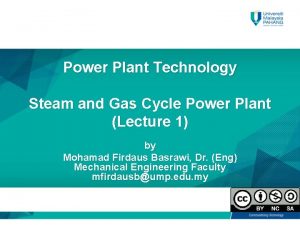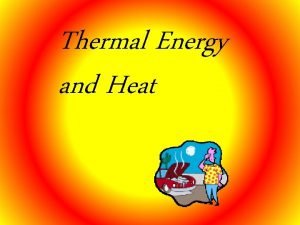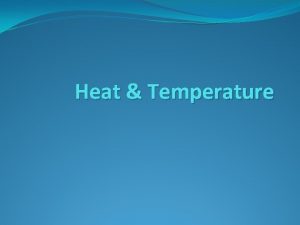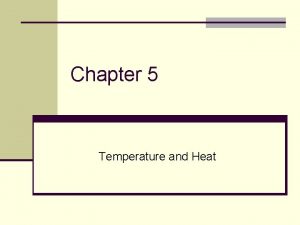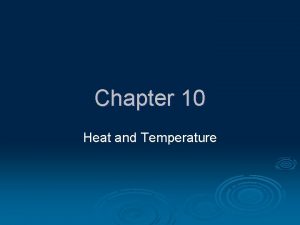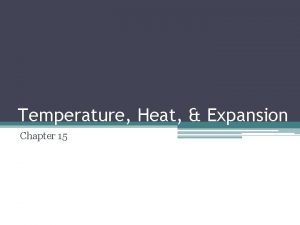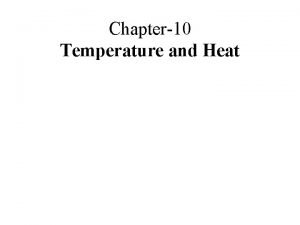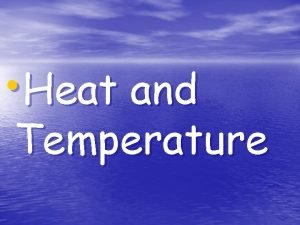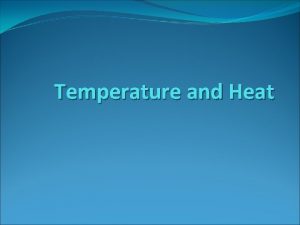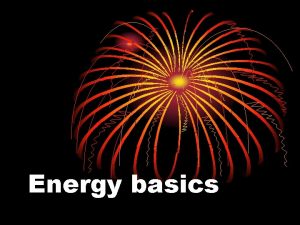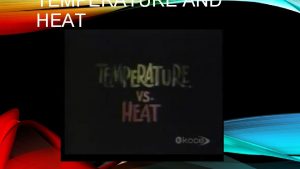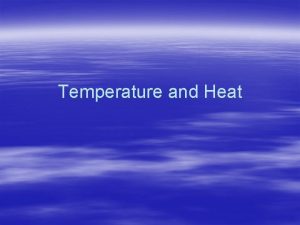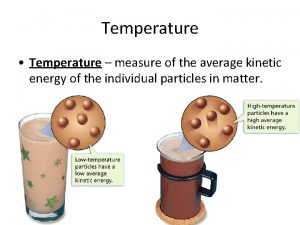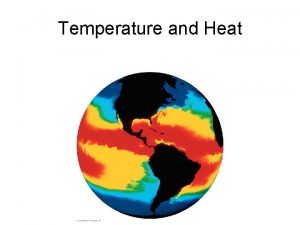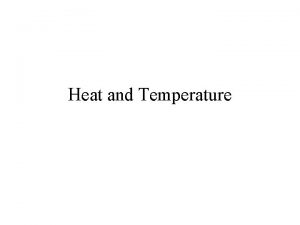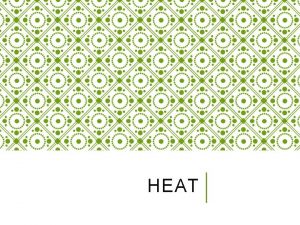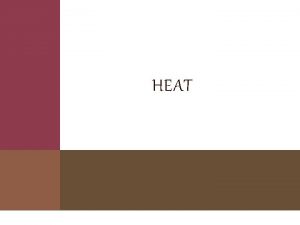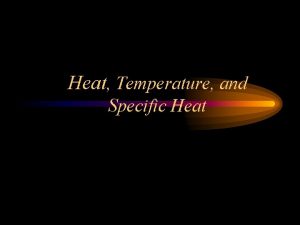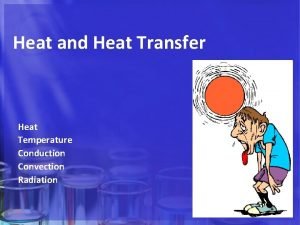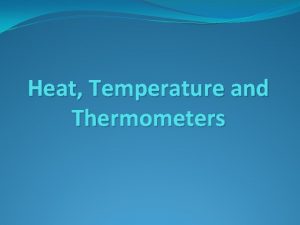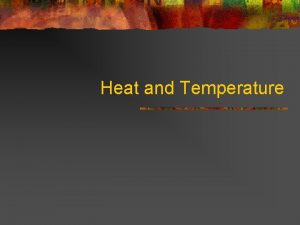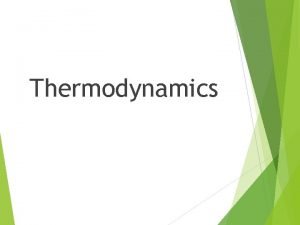Part 6 Temperature heat and thermodynamicsII Chapter 13






































- Slides: 38

Part 6 Temperature, heat and thermodynamics-II Chapter 13 Heat and Heat Transfer Methods

Energy Transfer n n n When two objects of different temperatures are placed in thermal contact, the temperature of the warmer decreases and the temperature of the cooler increases The energy exchange ceases when the objects reach thermal equilibrium The concept of energy was broadened from just mechanical to include internal n Made Conservation of Energy a universal law of nature

Heat n Heat is the transfer of energy between a system and its environment because of a temperature difference between them n The symbol Q is used to represent the amount of energy transferred by heat between a system and its environment

Internal Energy n Internal Energy, U, is the energy associated with the microscopic components of the system n n Includes kinetic and potential energy associated with the random translational, rotational and vibrational motion of the atoms or molecules Also includes any potential energy bonding the particles together

Heat Compared to Internal Energy n Important to distinguish between them n n They are not interchangeable They mean very different things when used in physics

Units of Heat n calorie n n An historical unit, before the connection between thermodynamics and mechanics was recognized A calorie is the amount of energy necessary to raise the temperature of 1 g of water from 14. 5° C to 15. 5° C. n A Calorie (food calorie) is 1000 cal

Specific Heat n n Every substance requires a unique amount of energy per unit mass to change the temperature of that substance by 1° C The specific heat, c, of a substance is a measure of this amount

Units of Specific Heat n SI units n n J / kg °C Historical units n cal / g °C

A Consequence of Different Specific Heats n n n Water has a high specific heat compared to land On a hot day, the air above the land warms faster The warmer air flows upward and cooler air moves toward the beach

Calorimeter n n One technique for determining the specific heat of a substance A calorimeter is a vessel that is a good insulator which allows a thermal equilibrium to be achieved between substances without any energy loss to the environment

Calorimetry n n Analysis performed using a calorimeter The energy that leaves the warmer substance equals the energy that enters the water n n Qcold = -Qhot Negative sign keeps consistency in the sign convention of ΔT

Calorimetry with More Than Two Materials n n In some cases it may be difficult to determine which materials gain heat and which materials lose heat You can start with SQ = 0 n n Each Q = m c DT Use Tf – Ti

Phase Changes n n A phase change occurs when the physical characteristics of the substance change from one form to another Common phases changes are n n n Solid to liquid – melting Liquid to gas – boiling Phases changes involve a change in the internal energy, but no change in temperature

Latent Heat n During a phase change, the amount of heat is given as n n L is the latent heat of the substance n n n Q = ±m L Latent means hidden L depends on the substance and the nature of the phase change Choose a positive sign if you are adding energy to the system and a negative sign if energy is being removed from the system

Latent Heat, cont. n n SI units of latent heat are J / kg Latent heat of fusion, Lf, is used for melting or freezing Latent heat of vaporization, Lv, is used for boiling or condensing Table 13. 2 gives the latent heats for various substances

Sublimation n Some substances will go directly from solid to gaseous phase n n Without passing through the liquid phase This process is called sublimation n There will be a latent heat of sublimation associated with this phase change

Graph of Ice to Steam

Warming Ice n n Start with one gram of ice at – 30. 0º C During A, the temperature of the ice changes from – 30. 0º C to 0º C Use Q = m c ΔT Will add 62. 7 J of energy

Homework n Calculate all the quatities you can get from the diagram in the previous PPT. Given m=1. 00 kg.

Problem Solving Strategies n Make a table n n A column for each quantity A row for each phase and/or phase change Use a final column for the combination of quantities Use consistent units

Problem Solving Strategies, cont n Apply Conservation of Energy n n n Transfers in energy are given as Q=mcΔT for processes with no phase changes Use Q = m Lf or Q = m Lv if there is a phase change In Qcold = - Qhot be careful of sign ΔT is Tf – Ti Solve for the unknown

Methods of Heat Transfer n n n Need to know the rate at which energy is transferred Need to know the mechanisms responsible for the transfer Methods include n n n Conduction Convection Radiation

Conduction n The transfer can be viewed on an atomic scale n n n It is an exchange of energy between microscopic particles by collisions Less energetic particles gain energy during collisions with more energetic particles Rate of conduction depends upon the characteristics of the substance

Conduction example n n The molecules vibrate about their equilibrium positions Particles near the stove coil vibrate with larger amplitudes These collide with adjacent molecules and transfer some energy Eventually, the energy travels entirely through the pan and its handle

Conduction, cont. n In general, metals are good conductors n n n They contain large numbers of electrons that are relatively free to move through the metal They can transport energy from one region to another Conduction can occur only if there is a difference in temperature between two parts of the conducting medium

Conduction, equation n The slab allows energy to transfer from the region of higher temperature to the region of lower temperature

Conduction, equation explanation n n A is the cross-sectional area L = Δx is the thickness of the slab or the length of a rod P is in Watts when Q is in Joules and t is in seconds k is thermal conductivity of the material n n See table 13. 3 for some conductivities Good conductors have high k values and good insulators have low k values

Convection n Energy transferred by the movement of a substance n n When the movement results from differences in density, it is called natural conduction When the movement is forced by a fan or a pump, it is called forced convection

Convection Current Example n n The radiator warms the air in the lower region of the room The warm air is less dense, so it rises to the ceiling The denser, cooler air sinks A continuous air current pattern is set up as shown

Radiation n Radiation does not require physical contact All objects radiate energy continuously in the form of electromagnetic waves due to thermal vibrations of the molecules Rate of radiation is given by Stefan’s Law

Radiation example n n n The electromagnetic waves carry the energy from the fire to the hands No physical contact is necessary Cannot be accounted for by conduction or convection

Radiation equation n n The power is the rate of energy transfer, in Watts σ = 5. 6696 x 10 -8 W/m 2. K 4 A is the surface area of the object e is a constant called the emissivity n n e varies from 0 to 1 T is the temperature in Kelvins

Energy Absorption and Emission by Radiation n With its surroundings, the rate at which the object at temperature T with surroundings at To radiates is n n When an object is in equilibrium with its surroundings, it radiates and absorbs at the same rate n Its temperature will not change

Ideal Absorbers n An ideal absorber is defined as an object that absorbs all of the energy incident on it n n n e=1 This type of object is called a black body An ideal absorber is also an ideal radiator of energy

Ideal Reflector n An ideal reflector absorbs none of the energy incident on it n e=0

Applications of Radiation n Body temperature n Radiation thermometer measures the intensity of the infrared radiation from the eardrum

Resisting Energy Transfer n n n Dewar flask/thermos bottle Designed to minimize energy transfer to surroundings Space between walls is evacuated to minimize conduction and convection Silvered surface minimizes radiation Neck size is reduced

Home Work n n Homework on PPT No. 19 Problem 13. 14 Problem 13. 46 Problem 13. 62(Optional)
 Specific heat of platinum
Specific heat of platinum Chapter 15 temperature heat and expansion
Chapter 15 temperature heat and expansion Chapter 21 temperature, heat and expansion answer key
Chapter 21 temperature, heat and expansion answer key Microscopic slush in water tends
Microscopic slush in water tends Chapter 14 section 1 heat and temperature answers
Chapter 14 section 1 heat and temperature answers Chapter 21 temperature heat and expansion
Chapter 21 temperature heat and expansion Chapter 21 temperature heat and expansion
Chapter 21 temperature heat and expansion Difference between curie temperature and neel temperature
Difference between curie temperature and neel temperature Difference between curie temperature and neel temperature
Difference between curie temperature and neel temperature Ferrimagnetism
Ferrimagnetism Thermal energy vs heat
Thermal energy vs heat Heat vs thermal energy
Heat vs thermal energy Heat thermal energy and temperature
Heat thermal energy and temperature Difference between heat and temperature
Difference between heat and temperature Heat thermal energy and temperature
Heat thermal energy and temperature Heat definitions
Heat definitions The difference between heat and temperature
The difference between heat and temperature Heat and temperature
Heat and temperature Relation between heat and temperature
Relation between heat and temperature Physics heat and temperature
Physics heat and temperature Plate type exchanger
Plate type exchanger Examples of convection
Examples of convection Temperature energy
Temperature energy Differentiate between heat and work
Differentiate between heat and work Oxygen index
Oxygen index Heat vs temperature
Heat vs temperature Heat vs temperature
Heat vs temperature Thermal energy vs heat
Thermal energy vs heat Is temperature a quantitative measure of heat
Is temperature a quantitative measure of heat Steady flow energy equation
Steady flow energy equation Is temperature a measure of thermal energy
Is temperature a measure of thermal energy Specific latent heat of water
Specific latent heat of water Properties of heat
Properties of heat It refers to dry heat cooking
It refers to dry heat cooking Chapter 16.4 measuring and recording respirations
Chapter 16.4 measuring and recording respirations Chapter 15:4 measuring and recording respirations
Chapter 15:4 measuring and recording respirations Part part whole addition
Part part whole addition Part to part ratio definition
Part to part ratio definition Part part whole
Part part whole
